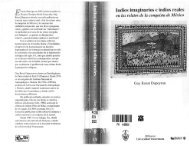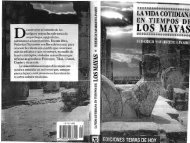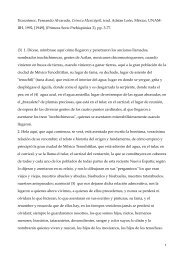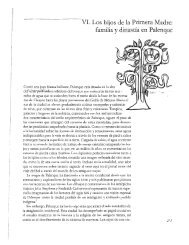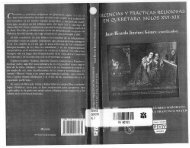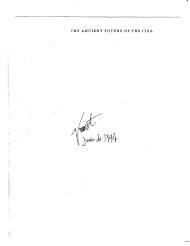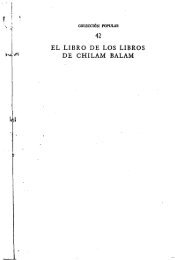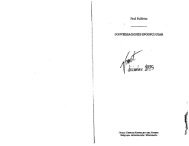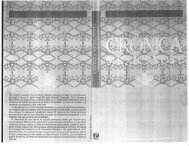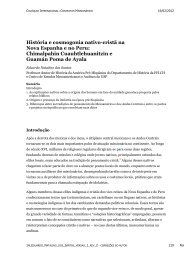HEAVEN BORN MERIDA AND ITS DESTINY - Histomesoamericana
HEAVEN BORN MERIDA AND ITS DESTINY - Histomesoamericana
HEAVEN BORN MERIDA AND ITS DESTINY - Histomesoamericana
You also want an ePaper? Increase the reach of your titles
YUMPU automatically turns print PDFs into web optimized ePapers that Google loves.
IO INTRODUCTION<br />
the Chumayel; the latest one known is the one cited above, 11.17.0.0.0,<br />
corresponding to 1559, the beginning of katun 9 Ahau. There is clear evidence<br />
that the Maya were still counting them at 12.0.0.0.0 (1618).<br />
The Hab. The use of the tun, katun, and baktun was unique to the<br />
Yucatecan Maya, but they shared with the other cultures of nuclear Middle<br />
America the 260-day tzol kin and the 365-day hab or "vague year."<br />
They reached this cycle by counting 18 uinals of 20 days each and adding<br />
another uinal of 5 days. The uinals of the hab are different from those of<br />
the tun because of these extra 5 days, so they were distinguished by being<br />
given names, and their days were numbered serially from 0 to 19 (or, in<br />
the last uinal, from 0 to 4; see appendix C).<br />
Also because of the extra 5 days, the tzol kin count operated differently<br />
within the hab from the way it worked in the tun. The first day of the<br />
year advanced by 5 day names each year, and, since 5 goes into 20 4 times,<br />
only 4 of the 20 sacred days (every fifth one) could begin the year. These<br />
were the yearbearers [ah cuch hab) or the four changers [can hel). The<br />
yearbearer that began the first uinal of a given year also began all the<br />
others.<br />
Different calendars used different yearbearers. The Olmecs, for example,<br />
used their equivalents of Type I (Imix, Cimi, Chuen, Cib). The Quiche,<br />
Cakchiquel, Ixil, and Classic Maya used Type II (Ik, Manik, Eb, Caban).<br />
The Aztecs, Tzotzil, and Tzeltal used Type III (Akbal, Lamat, Ben,<br />
Etz'nab). The colonial Maya used Type IV (Kan, Muluc, Ix, Cauac). The<br />
Type V set (Chicchan, Oc, Men, Ahau) is the focus of the Yucatecan<br />
Burner cycle of fire ceremonies, which is completed once in each quarter<br />
tzol kin (65 days). Each of the yearbearer sets is ranked; Kan, for example,<br />
is the senior yearbearer in the colonial Mayan system (see appendix C).<br />
Since 13 goes into 365 28 times with a remainder of 1, the numeral coefficient<br />
of the first day of the year advanced by 1 each year, thus producing<br />
a cycle of 13 years, each such cycle being associated with a direction.<br />
The cycle beginning with 1 Kan was east, 1 Muluc was north, 1 Ix west,<br />
and 1 Cauac south. The same day appeared with the same coefficient only<br />
after all four cycles had been completed, producing the kin tun y abil or<br />
calendar round of 52 years. In the colonial calendar, the calendar round<br />
began on 1 Kan in 1581, for example.<br />
The yearbearer for each year was also associated with a direction, the<br />
yearbearer for the current year always being seated in the east. At the beginning<br />
of the 5 dreaded days of the final uinal, Uayeb 'specter steps', the<br />
year's end ceremonies were initiated. These 5 were called nameless days<br />
[x ma kaba kin), although they were numbered and named normally both<br />
in the tzol kin count and in the hab count. The yearbearers were then rotated<br />
counterclockwise and the new year ceremonies were held, the yearbearer<br />
for the new year taking his seat in the east.<br />
The general relationship among these various cycles was well understood<br />
by the Maya. They realized that 73 tzol kins equaled 52 habs (52 x<br />
365 = 73 x 260). They knew that 72 habs equaled 73 tuns (72 x 365 =<br />
73 x 360). And they calculated that 9 x 65 = 13 x 45 = 585, just a day<br />
more than the Venus year of 584 days! They concluded that they were<br />
i<br />
right in<br />
Ont*<br />
three of<br />
by an ir<br />
Count,<br />
which v<br />
Tikal ca<br />
The Tik<br />
to 1539,<br />
From 15<br />
apan, an<br />
nial cale<br />
gest a fo<br />
does not<br />
TheT<br />
uinals ol<br />
Xiu cycl<br />
11.16.0.C<br />
The Ma)<br />
was held<br />
the proa<br />
rated firs<br />
year at ft<br />
the begk<br />
dating of<br />
Itza seate<br />
was dicta<br />
was unus<br />
TheM;<br />
before thi<br />
dar of Til<br />
uinal froi<br />
than thei:<br />
erally epc<br />
and the A<br />
those af te<br />
The Valla<br />
Ahau beg.<br />
mulgated<br />
of the kat<br />
sun priest<br />
figured ou<br />
20 tuns th<br />
day of the<br />
"katuns"•<br />
office unti<br />
on the 24-.<br />
All date. 1



